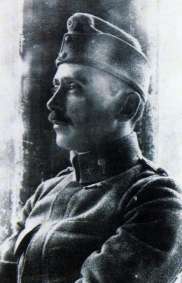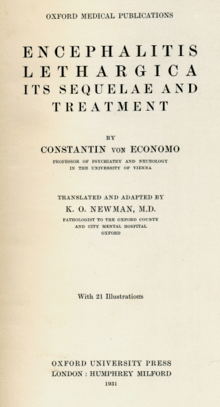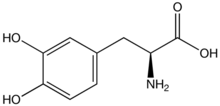Encephalitis lethargica
| Encephalitis lethargica | |
|---|---|
 | |
| First described by Constantin von Economo. | |
| Classification and external resources | |
| Specialty | infectious disease |
| ICD-10 | A85.8 |
| ICD-9-CM | 049.8 |
| DiseasesDB | 32498 |
Encephalitis lethargica or von Economo disease is an atypical form of encephalitis. Also known as "sleeping sickness" or "sleepy sickness" (distinct from tsetse fly-transmitted sleeping sickness), it was first described in 1917 by the neurologist Constantin von Economo[1][2] and the pathologist Jean-René Cruchet.[3]
The disease attacks the brain, leaving some victims in a statue-like condition, speechless and motionless.[4] Between 1915 and 1926,[5] an epidemic of encephalitis lethargica spread around the world. Nearly five million people were affected, a third of whom died in the acute stages. Many of those who survived never returned to their pre-existing "aliveness".
They would be conscious and aware – yet not fully awake; they would sit motionless and speechless all day in their chairs, totally lacking energy, impetus, initiative, motive, appetite, affect or desire; they registered what went on about them without active attention, and with profound indifference. They neither conveyed nor felt the feeling of life; they were as insubstantial as ghosts, and as passive as zombies.[6]
No recurrence of the epidemic has since been reported, though isolated cases continue to occur.[7][8]
Symptoms
The course of encephalitis lethargica can vary significantly between individuals, particularly when accompanied by preexisting or simultaneous diseases and disorders. It is characterized by high fever, sore throat, headache, lethargy, double vision, delayed physical and mental response, sleep inversion and catatonia.[4] In severe cases, patients may enter a coma-like state (akinetic mutism). Patients may also experience abnormal eye movements ("oculogyric crises"),[9] parkinsonism, upper body weakness, muscular pains, tremors, neck rigidity, and behavioral changes including psychosis. Klazomania (a vocal tic) is sometimes present.[10]
Cause

The causes of encephalitis lethargica (EL) are uncertain.[11]
Veins of modern research have explored its origins in an autoimmune response,[4] and, separately or in relation to an immune response, links to pathologies of infectious disease (viral and bacterial,[4] e.g., in the case of influenza, where a link with encephalitis is clear.[12] Postencephalic Parkinsonism was clearly documented to have followed an outbreak of EL following 1918 influenza pandemic; evidence for viral causation of the Parkinson's symptoms is circumstantial (epidemiologic, and finding influenza antigens in EL patients), while evidence arguing against this cause is of the negative sort (e.g., lack of viral RNA in postencephalic parkinsonian brain material).[12] In reviewing the relationship between influenza and EL, McCall and coworkers conclude, as of 2008, that while "the case against influenza [is] less decisive than currently perceived… there is little direct evidence supporting influenza in the etiology of EL," and that "[a]lmost 100 years after the EL epidemic, its etiology remains enigmatic."[8] Hence, while opinions on the relationship of EL to influenza remain divided, the preponderance of literature appears skeptical.[8][13]
In 2010, in a substantial Oxford University Press compendium reviewing the historic and contemporary views on EL, its editor, Joel VIlensky of the Indiana University School of Medicine, quotes Pool, writing in 1930, who states, "we must confess that etiology is still obscure, the causative agent still unknown, the pathological riddle still unsolved…", and goes on to offer the following conclusion, as of that publication date:
Does the present volume solve the "riddle" of EL, which… has been referred to as the greatest medical mystery of the 20th century? Unfortunately, no: but inroads are certainly made here pertaining to diagnosis, pathology, and even treatment."[14]
Subsequent to publication of this compendium, an enterovirus was discovered in EL cases from the epidemic.[15]
Diplococcus has been implicated as a cause of EL.[16]
Treatment
Modern treatment approaches to encephalitis lethargica include immunomodulating therapies, and treatments to remediate specific symptoms.[17]
Treatment for encephalitis lethargica in the early stages is patient stabilization, which may be very difficult. There is little evidence so far of a consistent effective treatment for the initial stages, though some patients given steroids have seen improvement.[18]The disease becomes progressive, with evidence of brain damage similar to Parkinson's disease.[19]
Treatment is then symptomatic. Levodopa (L-DOPA) and other anti-parkinson drugs often produce dramatic responses; however, most patients given L-DOPA experience ameliorations of the disease that are short lived.[20]
Notable cases
Notable cases include:
- Muriel "Kit" Richardson (née Hewitt), first wife of actor Sir Ralph Richardson, died of the condition in October 1942 having first shown symptoms in 1927–28.
- There is speculation that Adolf Hitler may have had encephalitis lethargica when he was a young adult (in addition to the more substantial case for Parkinsonism in his later years).[21][22][23][24]
Popular culture
Print and plays
Hawes, the curate in Agatha Christie's book The Murder at the Vicarage (1930), was described as suffering from this syndrome. The discovery by Oliver Sacks that L-DOPA could relieve some symptoms was described in his book Awakenings in 1973. The book was used by Harold Pinter as the basis of his one-act play A Kind of Alaska, performed in 1982 starring Judi Dench.
The disease plays a prominent role in the first issue of Neil Gaiman's comic book Sandman;[25] the disease, usually referred to by its nickname "sleepy sickness" and only once by its medical name, is attributed to the imprisonment of the sleep-master Dream in 1916 by an occultist. The novel Umbrella (2012) by Will Self centres on the occurrence of this disease and its later treatment with L-DOPA.
The disease is described in moderate detail in Peter Cummings' novel The Neuropathology of Zombies, in which a proposed mutated form of the disease is considered as the possible cause of a 'zombie' outbreak. It is also similar to the disease suffered by the "Hadens" in John Scalzi's novel Lock In. Encephalitis lethargica inspired the disease at the heart of Forrest Carr's post-apocalyptic sci-fi novel A Journal of the Crazy Year, and is investigated in the plot as a potential cause of the world-ending outbreak.[26]
Film and television
Encephalitis lethargica is researched and mentioned in the Canadian television show ReGenesis, in the last few episodes of the second series (2006). The disease is involved in one of the episodes in the American science fiction television show Alphas, called a "A Short Time in Paradise" (2011), in which the antagonist causes encephalitis lethargica to afflict his victims.. Awakenings is a 1990 film starring Robin Williams and Robert De Niro which is the dramatization of real-life neurologist Oliver Sacks' work with encephalitis lethargica patients.
Music
The 1980s US post-hardcore band Big Black recorded a song about the encephalitis lethargica epidemic called "L-Dopa" (1987).
Further reading
- Sacks O (1983). "The origin of 'Awakenings'". Br. Med. J. (Clin. Res. Ed.). 287 (6409): 1968–1969. doi:10.1136/bmj.287.6409.1968.
- Reid, A.H.; McCall, S.; Henry, J.M.; Taubenberger, J.K. (2001). "Experimenting on the Past: The Enigma of von Economo's Encephalitis Lethargica". J. Neuropathol. Exp. Neurol. 60 (7): 663–670. PMID 11444794. doi:10.1093/jnen/60.7.663.
- Foster H.D.; Hoffer A. (2004). "The Two Faces of L-DOPA: Benefits and Adverse Side Effects in the Ttreatment of Encephalitis Lethargica, Parkinson's Disease, Multiple Sclerosis and Amyotrophic Lateral Sclerosis". Med Hypotheses. 62 (2): 177–81. PMID 14962622. doi:10.1016/S0306-9877(03)00318-9.
- Vilensky, J.A.; Foley, P.; Gilman, S. (2007). "Children and Encephalitis Lethargica: A Historical Review". Pediatr. Neurol. 37 (2, August): 79–84. PMID 17675021. doi:10.1016/j.pediatrneurol.2007.04.012. Retrieved 8 December 2015.
- Vilensky, Joel A., ed. (2010). Encephalitis Lethargica: During and After the Epidemic. Oxford, ENG: Oxford University Press. ISBN 019045220X. Retrieved 8 December 2015.
- Crosby, Molly Caldwell (2010). 'Asleep: The Forgotten Epidemic that Remains One of Medicine's Greatest Mysteries. New York, NY, USA: Penguin/Berkley. Describes the history of the disease, and the epidemic of the 1920s.
References
- ↑ synd/3356 at Who Named It?
- ↑ K. von Economo. Encepahlitis lethargica. Wiener klinische Wochenschrift, May 10, 1917, 30: 581-585. Die Encephalitis lethargica. Leipzig and Vienna, Franz Deuticke, 1918.
- ↑ Cruchet R, Moutier J, Calmettes A. « Quarante cas d'encéphalomyélite subaiguë » Bull Soc Med Hôp Paris 1917;41:614-6.
- 1 2 3 4 Dale, Russell C.; Church, Andrew J.; Surtees, Robert A.H.; Lees, Andrew J.; Adcock, Jane E.; Harding, Brian; Neville, Brian G. R. & Giovannoni, Gavin (2004). "Encephalitis Lethargica Syndrome: 20 New Cases and Evidence of Basal Ganglia Autoimmunity". Brain. 127 (1): 21–33. PMID 14570817. doi:10.1093/brain/awh008. Retrieved 8 December 2015.
- ↑ "Encephalitis lethargica" at Dorland's Medical Dictionary
- ↑ Awakenings, Oliver Sacks, p. 14
- ↑ Stryker Sue B. "Encephalitis lethargica: the behavior residuals". Training School Bulletin. 22 (1925): 152–7.
- 1 2 3 Reid, A.H.; McCall, S.; Henry, J.M.; Taubenberger, J.K. (2001). "Experimenting on the Past: The Enigma of von Economo's Encephalitis Lethargica". J. Neuropathol. Exp. Neurol. 60 (7): 663–670. PMID 11444794. doi:10.1093/jnen/60.7.663.
- ↑ Vilensky, J.A.; Goetz, C.G.; Gilman, S. (2006). "Movement Disorders Associated with Encephalitis Lethargica: A Video Compilation". Mov. Disord. 21 (1, January): 1–8. PMID 16200538. doi:10.1002/mds.20722.
- ↑ Jankovic, J.; Mejia, N.I. (2006). "Tics Associated with Other Disorders". Adv. Neurol. 99: 66. PMID 16536352.
- ↑ McCall, S.; Vilensky, J.A.; Gilman, S.; Taubenberger, J.K. (2008). "The Relationship Between Encephalitis Lethargica and Influenza: A Critical Analysis". J. Neurovirol. 14 (3, May): 177–185. PMC 2778472
 . PMID 18569452. doi:10.1080/13550280801995445. Retrieved 8 December 2015.
. PMID 18569452. doi:10.1080/13550280801995445. Retrieved 8 December 2015. - 1 2 Haeman, Jang; Boltz, D.; Sturm-Ramirez, K.; Shepherd, K.R.; Jiao, Y.; Webster, R.; Smeyne, Richard J. (2009). "Highly Pathogenic H5N1 Influenza Virus Can Enter the Central Nervous System and Induce Neuroinflammation and Neurodegeneration" (PDF). Proceedings of the National Academy of Sciences. 106 (33, August 10): 14063–14068. PMC 2729020
 . PMID 19667183. doi:10.1073/pnas.0900096106. Retrieved 8 December 2015.
. PMID 19667183. doi:10.1073/pnas.0900096106. Retrieved 8 December 2015. - ↑ Vilensky, J.A.; Foley, P.; Gilman, S. (2007). "Children and Encephalitis Lethargica: A Historical Review". Pediatr. Neurol. 37 (2, August): 79–84. PMID 17675021. doi:10.1016/j.pediatrneurol.2007.04.012. Retrieved 8 December 2015.
- ↑ Vilensky, J.A.; Gilman, S. (2010). "Introduction". In Vilensky, Joel A. Encephalitis Lethargica: During and After the Epidemic. Oxford, ENG: Oxford University Press. pp. 3–7, esp. 6f. ISBN 019045220X. Retrieved 8 December 2015.
- ↑ Dourmashkin, Robert R.; Dunn, Glynis; Castano, Victor; McCall, Sherman A. (2012-01-01). "Evidence for an enterovirus as the cause of encephalitis lethargica". BMC Infectious Diseases. 12: 136. ISSN 1471-2334. PMC 3448500
 . PMID 22715890. doi:10.1186/1471-2334-12-136.
. PMID 22715890. doi:10.1186/1471-2334-12-136. - ↑ http://news.bbc.co.uk/1/hi/health/3930727.stm
- ↑ Lopez-Alberola, R; Georgiou, M; Sfakianakis, G.N.; Singer, C.; Papapetropoulos, S. (2009). "Contemporary Encephalitis Lethargica: Phenotype, Laboratory Findings and Treatment Outcomes". J. Neurol. 256 (3, March): 396–404. PMID 19412724. doi:10.1007/s00415-009-0074-4.
- ↑ Blunt, S.B.; Lane, R.J.; Turjanski, N.; Perkin, G.D. (1997). "Clinical Features and Management of Two Cases of Encephalitis Lethargica". Mov. Disord. 12 (3): 354–9. PMID 9159730. doi:10.1002/mds.870120314.
- ↑ Kohnstamm P (1934). Über die Beteiligung der beiden Schichten der Substantia nigra am Prozeß der Encephalitis epidemica. J Psychol Neurol 46(1): 22-37.
- ↑ Sacks, Oliver (1973). Awakenings. Duckworth & Co. ISBN 0-375-70405-1.
- ↑ Lieberman, A (April 1996). "Adolf Hitler Had Post-Encephalitic Parkinsonism". Parkinsonism Relat Disord. 2 (2): 95–103. PMID 18591024. doi:10.1016/1353-8020(96)00005-3.
- ↑ Boettcher, L.B.; Bonney, P.A.; Smitherman A.D.; Sughrue, M.E. (2015). "Hitler's Parkinsonism". Neurosurg Focus. 39 (1, July): E8. PMID 26126407. doi:10.3171/2015.4.FOCUS1563.
- ↑ Gupta, R; Kim, C; Agarwal, N; Lieber, B & Monaco, E.A. (2015). "Understanding the Influence of Parkinson's Disease on Adolf Hitler's Decision-Making During World War II". World Neurosurg. 84 (5, November): 1447–1452. PMID 26093359. doi:10.1016/j.wneu.2015.06.014.
- ↑ Rosen, Denis (2010). "Review: "Asleep: the Forgotten Epidemic That Remains One of Medicine's Greatest Mysteries" [Molly Caldwell Crosby". J. Clin. Sleep Med. 6 (3, 15 June): 299. PMC 2883045
 .
. - ↑ The Sandman: Preludes and Nocturnes, Sandman: Doll's House, and Sandman Vol. 1, 1991.
- ↑ Featured Novel at Fantascize.com
External links
- National Institute of Neurological Disorders and Stroke
- Mystery of the Forgotten Plague: BBC news item about the tracing of the infectious agent in encephalitis lethargica
